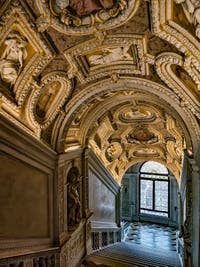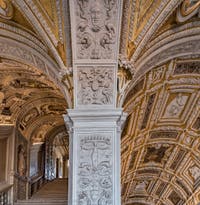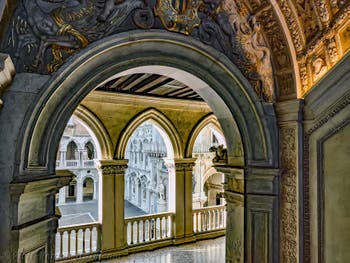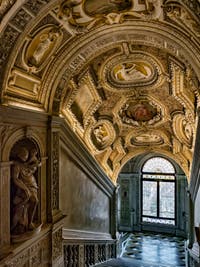Doge's Palace Art Story | Location | Opening Hours Tickets | Authorizations
Art Story Power | Tintoretto Paradise | Architecture | Staircases | Senate Collegio | Atrium
The Scala d'Oro, the Golden Staircase of the Doge's Palace in Venice

Golden Staircase The Scala d'Oro is undoubtedly the richest staircase in the world.
The golden staircase owes its name to the magnificence of its classical, Roman-style decoration, with white and gold stucco.
His motifs illustrate the power of Venice over the seas, its defence of Crete and Cyprus, as well as the virtues essential to be able to govern well.
Its first part provides access to the doge's apartment of honour and its private apartments, while the second volley of steps leads to the Atrium Square and the heart of the palace.
This extraordinary staircase offers two opposite views, one of the majestic courtyard of the Doge's Palace and the other over the Rio de la Canonica straddled by the Bridge of Sighs.
A Golden and ceremonial staircase for receptions
The parades in honour of the famous visitors entered the Doge's Palace through the Porta della Carta, then took the monumental Giant's Staircase, and then reached the foot of the Scala d'Oro.
Golden Staircase By taking this staircase, we reached the centre of power of the Serenissima: the reception rooms of the doge as well as those of the Senate and Collegio.
This succession of monumental artistic works of incomparable wealth aimed to impress the distinguished visitors: kings, princes, foreign ministers and ambassadors!
A way for Venice to show its power and spread its wealth before moving on to possible negotiations.
Henry III, king of France and Poland, had the honour of climbing this golden staircase during his visit to Venice in 1574.
This Golden Staircase was exclusively reserved for illustrious visitors, and apart from these, only high-ranking magistrates of the Republic of Venice had the right to use it.
Construction of the Scala d'Oro

Golden Staircase This staircase was built in such a way as to fill the existing space between the apartments of the doge and the courthouse rooms which were inside the Doge's Palace itself.
La Scala d'Oro was one of the last major works made in the Doge's Palace during the 16th century.
The construction project was initiated under the Doge Andrea Gritti.
An architectural project entrusted to Jacopo Sansovino in 1538.
The project was then redesigned by the same Sansovino in 1555, before culminating in the construction of the current Scala d'Oro, under the direction of the architect Antonio Abbondi, known as Scarpagnino in 1559.
Stucco and Frescoes of the Scala d'Oro
The sculptor Alessandro Vittoria was responsible for decorating the Scala d'Oro in white and gold stucco.It is not by chance that this decoration of the Golden Staircase was entrusted to Vittoria.
Alessandro Vittoria began his career as a sculptor at the age of 18, in Jacopo Sansovino's studio, with whom he collaborated to make the sculptures of the Marciana Library in 1550.

Golden Staircase The painter Giambattista Franco was charged with the frescoes of the ceiling of the Golden Staircase.
In the lower part of the Golden Staircase, Franco's frescoes are a glorification of the defence of Crete and Cyprus, while in the upper part they magnify the virtues of which a good doge must be inspired.
The frescoes are beautifully presented in stucco frames created by Alessandro Vittoria, harmoniously integrated frames and perfectly aligned with the vault line of the staircase.
It is noteworthy that the side walls of the Scala d'Oro are... smooth, without any decoration.
The reason is in no way related to a possible lack of money to complete the decoration of the Golden Staircase.
This choice is simply the result of the desire to create a contrast with the richness of the ceiling decoration in order to emphasize it.
The Sculptures of the Golden Staircase
The entrance arch of the staircase is flanked by two columns, each supporting a marble sculpture.These sculptures were made by artist Tiziano Aspetti and represent respectively "Hercules killing the Hydra" and "Atlas carrying the world".
Halfway through the second flight of steps, before arriving at the Atrium square, we discover two other beautiful sculptures, "Abundance" and "Charity", by Francesco Segala.
And even if you are not an ambassador, no prince or princess, you will have the pleasure, thanks to the modern world, of climbing the steps of this unique architectural and artistic jewel in the world.
Take your time, you will be amply rewarded!
Art Story Power | Tintoretto Paradise | Architecture | Staircases | Senate Collegio | Atrium
Doge's Palace Art Story | Location | Opening Hours Tickets | Authorizations
Back to Top of Page

